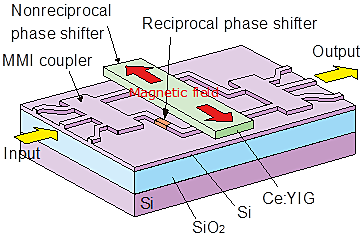| Pioneering Work on Optical Nonreciprocal Circuits |
| Tetsuya Mizumoto |

@ The evolution of optical fiber communications has extended information communication services. It impacts individuals as well as business activities. Optical fiber communication technology is expected to play more important roles in interconnections requiring high-speed signal transmission. Optical nonreciprocal devices permit optical signals to be transmitted in a predetermined direction, but not to propagate in other directions. They play an essential role in stabilizing optical active devices for light transmission systems.
@ Similarly to devices in the microwave frequency region, optical isolators were developed in bulk form on the basis of the Faraday effect that rotates the polarization in different ways depending on the light propagation direction. Waveguide optical nonreciprocal devices such as waveguide isolators were investigated for application in integrated optics. In the early stage of research, optical isolators based on polarization rotation in waveguides were investigated [1]. The velocity of lightwaves propagating in a waveguide depends on the polarization mode. Therefore, the phase matching between TE and TM modes is an issue that must be resolved in a waveguide isolator based on polarization rotation. This results in a difficulty in realizing devices from the practical viewpoint of fabrication tolerance and operation bandwidth [2].
@ The recipient used an approach based on a single polarization operation using a nonreciprocal phase change, which comes from the different propagation velocities depending on the light propagation direction. He measured the nonreciprocal phase change for the first time in a magnetooptic waveguide [3]. Waveguide optical nonreciprocal devices such as isolators and circulators are constructed by utilizing the direction-dependent phase change in an interferometer.
@ The optical nonreciprocal phase change is obtainable in a waveguide where a magnetooptic material is used as a guiding or cladding layer. An optical isolator is realizable in a III-V compound semiconductor waveguide on which a magnetooptic material is loaded as a cladding layer [4]. That is, the optical isolator can be integrated with a semiconductor laser. The remaining issue to be resolved is the integration of semiconductors with a magnetooptic garnet crystal having a large magnetooptic effect and a low optical absorbance at an optical fiber communication wavelength.
@ The recipient introduced a direct bonding technique. It is quite difficult to grow a magnetooptic garnet crystal on semiconductors because of the large mismatch in crystallographic characteristics between garnet and semiconductors. In the early 1990s, the direct bonding technique was successfully applied to the combination of dissimilar crystals such as III-V compound semiconductors on silicon and silicon on silica. He succeeded in bonding a magnetooptic garnet crystal on GaInAsP with practically sufficient bonding strength using a surface-activated direct bonding technique [5]. Using this technique, an optical isolator was fabricated in a GaInAsP waveguide based on a nonreciprocal phase change [6]. Also, by using a similar principle and fabrication technique, a silicon waveguide optical isolator was fabricated on an SOI (silicon-on-insulator) wafer (Fig. 1) [7]. The result has attracted much attention in the field of silicon photonics, which has been intensively investigated worldwide.
@ The recipient also supervises a number of students in his institute through research and educational activities, who play important roles in IEICE. IEICE bestows on him a worthy recipient of IEICE achievement award for his outstanding contributions to IEICE.
| References | |
| [1] | @K. Ando, T. Okoshi, and N. Koshizuka, gWaveguide magneto-optic isolator fabricated by laser annealing,h Appl. Phys. Lett., vol. 53, pp. 4-6 (1988). |
| [2] | T. Mizumoto, Y. Kawaoka, and Y. Naito, gWaveguide-type optical isolator using the Faraday and Cotton-Mouton effects,h Trans. IECE Japan, vol. E69, pp. 968-972 (1986). |
| [3] | @T. Mizumoto and Y. Naito, gNonreciprocal propagation characteristics of YIG thin film,h IEEE Trans. Microwave Theory and Tech., vol. MTT-30, pp. 922-925 (1982). |
| [4] | @H. Yokoi and T. Mizumoto, gProposed configuration of integrated optical isolator employing wafer-direct bonding technique,h Electron. Lett., vol. 33, pp. 1787-1788 (1997). |
| [5] | @R. Takei, K. Abe, and T. Mizumoto, gRoom-temperature direct bonding for integrated optical devices,h IEEE LEOS Annual Meeting (LEOS), Lake Buena Vista, Florida, TuD4 (Oct. 2007). |
| [6] | @H. Yokoi, T. Mizumoto, N. Shinjo, N. Futakuchi, and Y. Nakano, gDemonstration of an optical isolator with a semiconductor guiding layer that was obtained by use of a nonreciprocal phase shift,h Appl. Opt., vol. 39, pp. 6158-6164 (2000). |
| [7] | @Y. Shoji, T. Mizumoto, H. Yokoi, I. -W. Hsieh, and R. M. Osgood, Jr., gMagneto-optical isolator with silicon waveguides fabricated by direct bonding,h Appl. Phys. Lett., vol. 92, 071117 (2008). |

Fig. 1 SOI-based waveguide optical isolator [7]